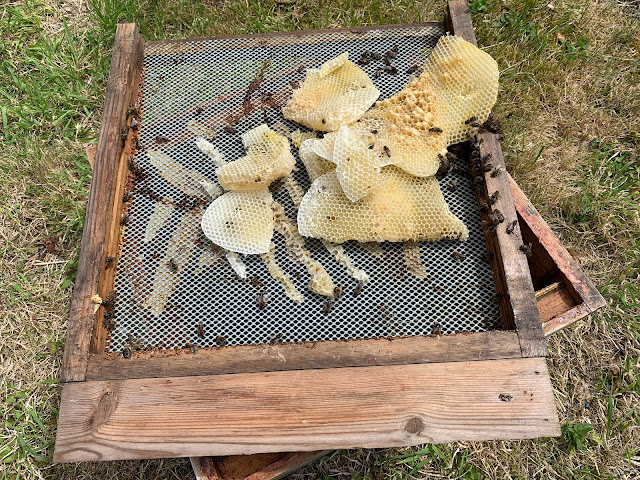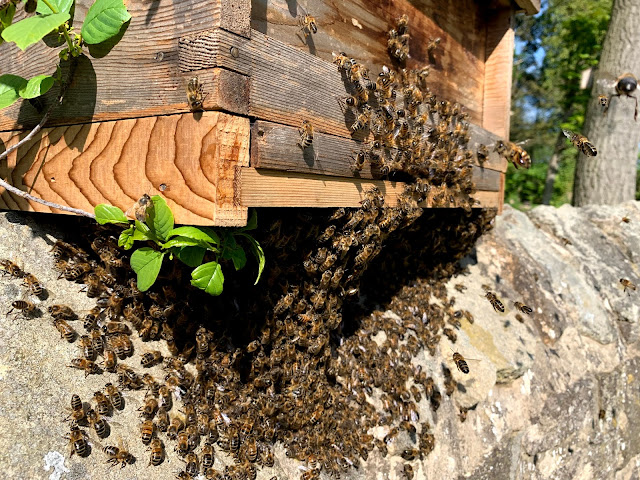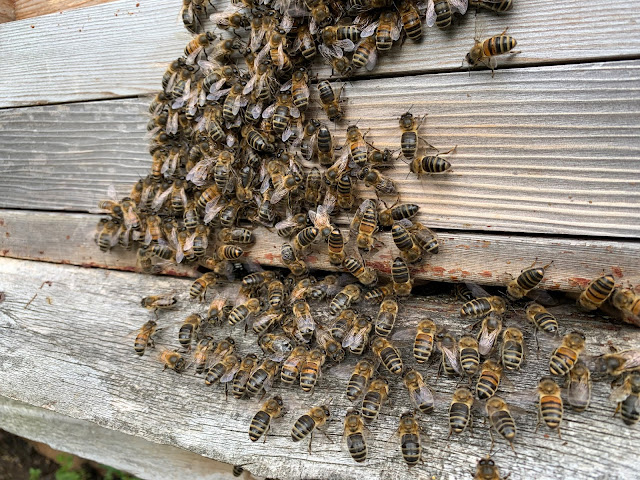TrogTrogBee
Saturday, 14 October 2023
Ivy Pollen
Tuesday, 23 May 2023
Another lesson learned
Friday, 8 July 2022
Squatters
Friday, 23 July 2021
Front page news
Wednesday, 9 June 2021
Inbound
I had been expecting a swarm because there had been lots of scout bees around my bait hive but I didn't know when it would arrive or where it was coming from. I have had a few swarms of my own after the very cold weather in most of May followed by sudden warmth at the end of the month and I suspected it would be from one of my hives. I also heard news of a swarm in a tree not far away on the other side of the golf course.
In the end the swarm's arrival was very sudden so I didn't see from which direction it came. I had walked past the bait hive a minute before with no sign of bees and when I returned there were thousands and thousands of bees in the air. Almost immediately they started filing into the box.
In retrospect the bait hive wasn't well situated as it was on top of a wall with quite an overhang. Many of the bees landed on the side of the wall and walked up towards the hive entrance.
Such was their weight as they climbed up over each other that great clumps of them broke off and fell into the grass so they had to start all over again.
It was fascinating to see how they formed chains so that the others could climb up to the entrance.
It was also interesting to see quite a few drones and some workers with pollen, all swept along in the excitement. I can tell from their colour these were not my bees and I hadn't lost a swarm that morning so I think this may have been the swarm from the golf course.
This was the scene 25 minutes after they arrived, with some still under the overhang but nearly all inside the box.
By the following morning the bees were safely installed on a friend's allotment in Jesmond. I hope they turn out to be well behaved.
Sunday, 23 May 2021
A mating flight (I think)
Glancing out of the window this morning I saw a lot of bees in the air. At first I thought this was another swarm but it was coming from hive 4, which shouldn't be able to swarm as it was reduced to one sealed queen cell 10 days before. I went over to watch and there were thousands of bees in the air - and on the hive roofs and nearby raspberry canes and cane supports.
Most of the bees were just sitting around while others flew about excitedly but there was no sign of them coalescing, as in a swarm. There were a lot on the front of the hive and a clump under the landing board.
I guessed this was a mating flight but wasn't sure what stage it was at - whether this was the virgin queen leaving or returning. I watched for about an hour, hoping I might see the queen return. As I did so the fanning slowly subsided and the number of bees gradually diminished as they moved back inside.
It was cool (11℃), grey and breezy, perhaps not the best weather for a mating flight, but it has been worse recently. I read since that mating flights last for between 5 and 30 minutes so my guess is that the queen was probably already back in the hive by the time I got there. I'll wait another two or three weeks before checking that she is laying well.







































